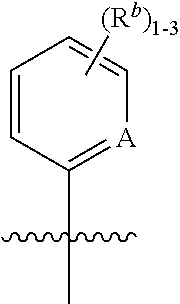P2x3, receptor antagonists for treatment of pain
a p2x3, receptor-based technology, applied in the field of compounds, can solve the problems of complex utility of purinergic ligands available to evaluate the role of individual p2 receptor subtypes in mammalian physiology, intense pain, and pronounced increase in sensory nerve discharg
- Summary
- Abstract
- Description
- Claims
- Application Information
AI Technical Summary
Problems solved by technology
Method used
Image
Examples
example 1.74
[0143]
1-(5-Fluoropyridin-2-yl)-N-{(1R)-1-[1-oxido-6-(trifluoromethyl)pyridin-3-yl]ethyl}-3-phenyl-1H-pyrazole-4-carboxamide
Step A: Methyl 3-phenyl-1H-pyrazole-4-carboxylate
[0144]To a solution of 3-phenyl-1H-pyrazole-4-carboxylic acid (1.0 g, 5.31 mmol) in dichloromethane (14.2 mL) and methanol (3.5 mL) was added trimethylsilyldiazomethane (2.66 mL, 5.31 mmol). The mixture was stirred at ambient temperature. After 30 min, additional trimethylsilyldiazomethane (0.80 mL, 1.59 mmol) was added. After 10 min, the mixture was concentrated. Purification by silica gel chromatography (100% dichloromethane→90% dichloromethane / methanol) gave the title compound (0.9 g). MS 203.1 (M+1).
Step B: Methyl 1-(5-fluoropyridin-2-yl)-3-phenyl-1H-pyrazole-4-carboxylate
[0145]To a solution of methyl 3-phenyl-1H-pyrazole-4-carboxylate (0.50 g, 2.47 mmol) in toluene (9.9 mL) were added 2-bromo-5-fluoropyridine (0.52 g, 2.97 mmol), (1S,2S)—N,N′-dimethylcyclohexane-1,2-diamine (78 μL, 0.50 mmol), copper(I) iodid...
example 1.127
[0148]
1-(5-Fluoropyridin-2-yl)-3-(1-hydroxy-2-methylpropyl)-N-{(1R)-1-[1-oxido-6-(trifluoromethyl)pyridin-3-yl]ethyl}-1H-pyrazole-4-carboxamide
Step A: 2-{[tert-Butyl(dimethyl)silyl]oxy}-3-methylbutanoic acid
[0149]To a solution of 2-hydroxy-3-methylbutanoic acid (5.0 g, 42.3 mmol) in DMF (21.2 mL) at 0° C. were added imidazole (6.34 g, 93.0 mmol) and DMAP (1.55 g, 12.7 mmol). The mixture was stirred for 5 min and TBDMS-Cl (14.0 g, 93.0 mmol) was added. The mixture was allowed to warm to ambient temperature. After 18 h, HCl (1.0 M in water) was added and the mixture was extracted with ethyl ether. The organic layer was washed with sat. NaHCO3, brine, dried over MgSO4, filtered and concentrated. The crude product was dissolved in THF (25 mL) and a solution of KOH (7.12 g, 127 mmol) in THF (130 mL) and water (40 mL) was added at 0° C. The mixture was stirred for 1 h. The solution was acidified and the mixture was extracted with ethyl acetate (5×). The combined organic extracts was dried...
example 1.131
[0156]
1-(5-Fluoropyridin-2-yl)-3-(2-methyl-1,3-thiazol-5-yl)-N-{(1R)-1-[1-oxido-6-(trifluoromethyl)pyridin-3-yl]ethyl}-1H-pyrazole-4-carboxamide
Step A: Ethyl 3-iodo-1H-pyrazole-4-carboxylate
[0157]To a solution of ethyl 3-amino-1H-pyrazole-4-carboxylate (10.0 g, 64.5 mmol) in diiodomethane (130 mL, 1.61 mol) at −10° C. was added isoamyl nitrite (156.0 mL, 1.16 mol). The mixture was allowed to warm to ambient temperature then heated to 100° C. After 2 h, ethyl acetate was added. The mixture was washed with saturated aqueous Na2SO3, HCl (1N in water) then water. The organic layer was dried over MgSO4, filtered and concentrated. Purification by silica gel chromatography (100% hexanes→50% hexanes / ethyl acetate) gave the title compound (9.63 g). MS 267.1 (M+1).
Step B: Ethyl 1-(5-fluoropyridin-2-yl)-3-iodo-1H-pyrazole-4-carboxylate
[0158]To a solution of ethyl 3-iodo-1H-pyrazole-4-carboxylate (8.5 g, 32.0 mmol) in DMF (160 mL) was added 2,5-difluoropyridine (11.0 g, 96.0 mmol) and potassium...
PUM
| Property | Measurement | Unit |
|---|---|---|
| body weight | aaaaa | aaaaa |
| body weight | aaaaa | aaaaa |
| temperature | aaaaa | aaaaa |
Abstract
Description
Claims
Application Information
 Login to View More
Login to View More - R&D
- Intellectual Property
- Life Sciences
- Materials
- Tech Scout
- Unparalleled Data Quality
- Higher Quality Content
- 60% Fewer Hallucinations
Browse by: Latest US Patents, China's latest patents, Technical Efficacy Thesaurus, Application Domain, Technology Topic, Popular Technical Reports.
© 2025 PatSnap. All rights reserved.Legal|Privacy policy|Modern Slavery Act Transparency Statement|Sitemap|About US| Contact US: help@patsnap.com



